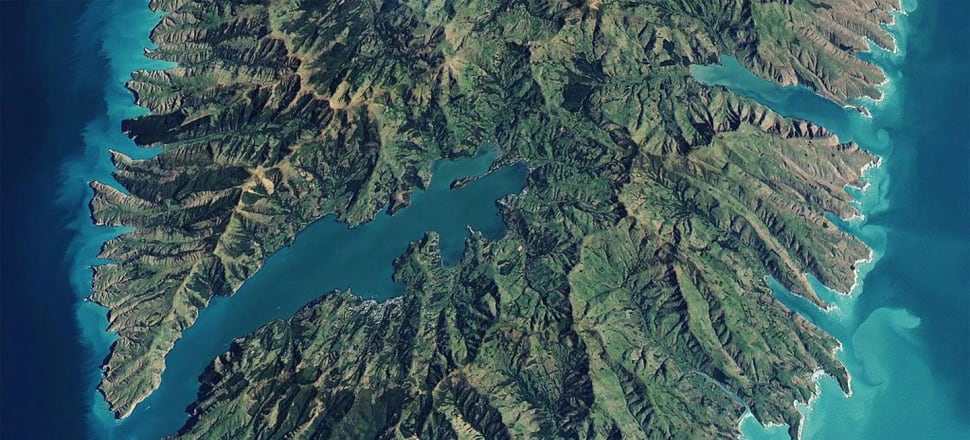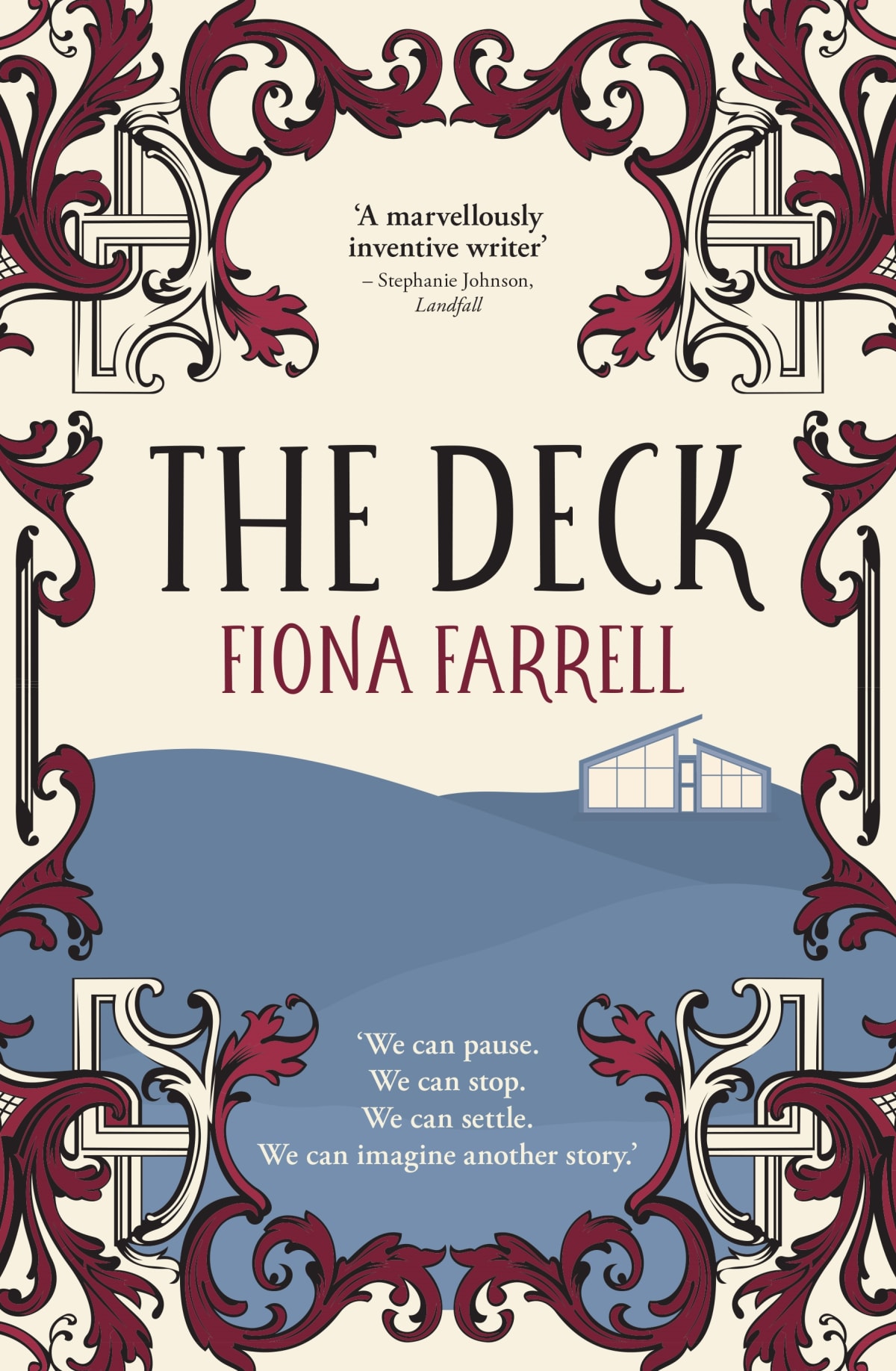
Paddy Richardson is swept away by a magical new novel
I love novels that you fall into and languish, trusting that each word will be perfectly placed, that each action will be either consistent or surprising, that each character will be rounded and real. Fiona Farrell’s sumptuously written, impeccably paced and frankly terrifying new novel, The Deck, exactly fits.
As well as Covid being an obvious inspiration, plagues of the past also underpin the narrative, as Farrell’s fictional world is menaced by a new pandemic. Farrell imposes an elegant structure on her novel by framing it within non-fiction first and last chapters, wherein ‘the novelist’ contemplates the Covid pandemic and subsequent social unrest. To provide a paradigm for the telling of her characters’ stories, she uses Giovanni Baccacio’s 14th Century classic The Decameron in which 10 Florentines escape to the country to avoid the raging bubonic plague where they each tell a story over 10 days: “one hundred tales of love and adventure and a grunty sexual comedy.”
In these framing chapters, the author also reflects about the terror, the anger, the attempts at cures and general social unrest experienced during past scourges. It is a little comforting to know that pandemics are not unique, that the past demonstrates they come and go, but ultimately the world recovers. However, alongside the fictional pandemic, Farrell creates, just as alongside our own Covid, the world also must confront the gathering forces of climate crisis.
The author crosses from her own world presently overshadowed by the Covid pandemic to the fictional. She gathers her characters, or as she calls them, "paper dolls". A cross-section of a faction of society; ageing, educated, middle class, is selected. Phillippa and Tom are a long-married couple, not quite so easy with each other now that their busy and satisfying careers are over. Ani, Phillippa’s best-loved friend is an artist and widow, still grieving, for her husband, Leo, after rather too many years, according to Phillippa, “It’s not healthy.” Ani has an added burden; adopted from birth she has no knowledge of her heritage other than that her adoptive parents discovered her via a newspaper advertisement – "For adoption. Baby Girl, half caste.” Baz, Tom’s friend, is a surfer and free spirit who pursues the waves, carrying his surfboard and worldly possessions in his disintegrating van. Pete, Ani’s gay brother has at long last found the love of his life in Didi, who is not only beautiful, “with a halo of curls and the face of an angel,” but, very happily for those in the group, a professional chef. And finally, joining them unexpectedly is Maria, Phillippa’s glamorous, estranged, film-making sister along with her granddaughter, Zoe, who she has kidnapped – or is it rescued? And so. The conventional, the non-conventional, the cook, the misfit, the child are assembled together.
The chapter entitled ‘The First Day’ takes us into the ordinariness of the supermarket which is not so ordinary after all. Phillippa has an unusually abusive encounter with another shopper who she asks to move aside. As she continues around the shelves, an old man drops to the floor, “crimson froth bubbles at his gaping mouth and then there is a gush of blood, so much blood, his dry stick body convulsing and thrashing on the floor." This is it, the unmistakable evidence that the new variant has vaulted New Zealand borders.
But what better way of avoiding the variant and having a good time as well than for friends to leave the city and enjoy a short break in Phillippa’s and Toms’ holiday house in Banks Peninsula? The bush, the glittering ocean, the hills, and the spread of sky, all of this as well as the newly completed ‘crib’ which epitomises Tom’s cleverness as a formerly prominent architect. Tom has designed a miracle of timber and glass, heating and water systems, concrete and light which slams and pours, with the piece de resistance being three black boxes which, with the click of buttons and various machinations, transform into sleeping pods.
This is the imaginary land Farrell has created for the characters she will observe with an unflinching eye as they eat, drink, walk, swim, laugh, weep and tell their stories over the following six days and four nights. But while the setting is idyllic, the circumstances are far from it; the pandemic is spreading, there is an impending lockdown. But why not enjoy a mini break while they still can? Besides, it’s Tom’s birthday and Phillippa knows he will behave more sociably, than is presently normal with just herself, in a group.
During the days we follow these characters with Farrell deftly providing us with insight into their reflections, memories, secrets and fears. These are the inner stories, whereas at night, like the 10 Florentines, they tell their stories; poignant, joyous, important, surprising stories which reveal what is at the heart of each teller. Ani tells the story of how her very good life as a wine-maker went very wrong, except that at the end of disaster she found Leo. Tom tells the story he has “told many times. It pleases him” about deer hunting, about meeting “this beautiful girl”. He wakes to find her naked beside him and, “let’s just say it was probably the best night of Tom’s life, before or since”. Baz tells his story of brothers, a brutal father, a powerless mother, and escape. Didi tells a story of pirates, threat and excitement and learning to cook while Pete tells his own story of cruises and singing and entertainment and how he re-found Didi, once Danny De Cicco, the love of his life.
Phillippa‘s story of the baby she gave birth to and Maria’s story about her brutal treatment of Baz before she left New Zealand, are particularly jarring. Phillippa’s story shocks, both in the details of her young self, giving birth alone in a caravan and in the implications of the story; this has been the secret she has kept for all of her life even from her husband. Tom and Phillippa were unable to have children; is it cruel to finally reveal to him in the company of others that she had a child or is it a kind of revenge for all the many times he has told his rather hurtful and tiresome tale of the beautiful naked woman? She finishes her story, very much as Tom finished his own, "And that was the most amazing night of my life.” Maria’s story of her careless and cruel treatment of Baz before, as a young woman, she left New Zealand, is equally disturbing, though, in this case it is offered as a confession, an apology. Amongst the convivial drinking, laughter, the perfection of setting, these intensely private revelations increase a gathering sense of foreboding. The immediate future is no longer reliable; perhaps there will be no other chances to tell the secrets that have lain dormant all these years.
Farrell creates an idyllic natural setting through lush, vivid, sumptuous, imagery, “the sun sets in a glory of red and gold, great theatrical swags of colour that fade deep blue as night washes into the valley. The moon hangs overhead, a pale disc.” But while the characters swim, surf and wander drawing serenity and rejuvenation from their surroundings, there is a growing atmosphere of threat. Their thoughts frequently turn to the world beyond them which is in disarray. Whole species are being decimated or entirely lost. The property is in a cellular dead-zone so that they have no knowledge of what is happening outside their immediate environment; a battered ketch appears and hovers silently in the bay with no sign of anyone on board. Maria reflects on her daughter, Sophie, who, in response to the pandemic, has entered a rabbit-hole of craziness and is now on her way to Metanoia and The Transformation. Stealing her granddaughter, Zoe, seemed the only answer. On their last night a ferocious storm hits with thunderclaps, torrential rain, flashes of lightening, hailstones the size of golf-balls. The power fails and,” The house that had seemed so solid, commanding the view, feels flimsy now, cruelly exposed up there on its ridge.”
On the morning of their departure, there are further signs of impending disaster. The power is still lost, the shutters on Tom’s cleverly designed pods won’t work and their vehicles are useless when they arrive at the gaping chasm created by the storm. While the others argue about what should be done, Zoe, strides forward. She, alone of the group, has not told a story but has lived one; a gentle story of sleeping amongst the trees alongside a deer. Perhaps her taking the lead amongst the flummoxed adults and her meeting with the deer suggest there will, after all, be a future. Perhaps Zoe will have her own stories to tell at the end of a long life. Perhaps there is, after all, some hope.
The last chapter returns us to the novelist who leaves her paper dolls in their imaginary land and reflects on the many changes there has been within her own world since she embarked on her novel. Covid has swept through the world bringing deaths and mayhem. What is the point, she reflects, on creating other worlds when our own world is in such peril? Still, stories transport us into new worlds where we can dwell for a while and emerge rejuvenated and with more perception, more awareness. They can bring a sense of order when everything seems out of kilter, they bring us new insights, new understanding.” We can pause. We can stop. We have a choice. We can imagine another story.”
The Deck by Fiona Farrell (Penguin Random House, $37) is available in bookstores nationwide.








